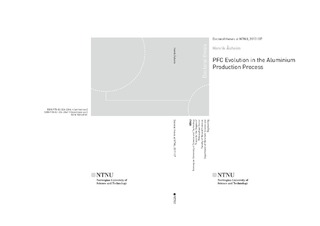| dc.contributor.advisor | Haarberg, Geir Martin | |
| dc.contributor.advisor | Sandnes, Espen | |
| dc.contributor.advisor | Solheim, Asbjørn | |
| dc.contributor.advisor | Aarhaug, Thor Anders | |
| dc.contributor.author | Åsheim, Henrik | |
| dc.date.accessioned | 2017-05-31T06:54:18Z | |
| dc.date.available | 2017-05-31T06:54:18Z | |
| dc.date.issued | 2017 | |
| dc.identifier.isbn | 978-82-326-2347-1 | |
| dc.identifier.issn | 1503-8181 | |
| dc.identifier.uri | http://hdl.handle.net/11250/2443916 | |
| dc.description.abstract | Improvements in the Hall-Héroult process for electrowinning of aluminium have drastically reduced the anode effect duration, frequency and its associated perfluorocarbon (PFC) evolution, especially over the past 50 years. Not too long ago it was desirable to have at least one anode effect (AE) per cell day to be sure no sludge had formed under the metal pad, however, with the advent of modern process control this became unnecessary and the frequency is today less than 0.1 AE per cell day for modern cells. With improved process control and better analysis equipment PFCs were also found be evolved outside of the traditional AE phenomena, and at normal electrolysis potentials. Albeit small in magnitude, the cumulative emissions could be substantial.
To be able to visualise the phenomena in the laboratory a system with more than one anode was created. It was found that low cell-voltage PFC evolution is not specific to any cell size or technology, but can develop all the way from the large industrial cell with 40 plus anodes and down to the smallest laboratory cell with a single anode. The probability and recurrence are, however, very much related to cell properties such as the number of parallel anodes and electrolyte/alumina mixing. With a smaller cell there is less room for redistribution of current between the parallel segments without an abrupt increase in voltage, and at the extremity of one anode, redistribution can only occur by introducing a current gradient within that segment. Similarly, sheer cell size and electrolyte mixing may further enhance such a redistribution of current. With a lower possibility of redistribution it is less likely with small bursts of PFC from one or a few anodes, and the cell will instead enter the conventional anode effect accompanied by high voltage.
The initiation of the low cell-voltage anode effect looks to develop in the same manner as that of the conventional anode effect with the aforementioned properties of the cell dictating if it will be a passing evolution of PFC, or if it will propagate into a full conventional anode effect.
Anodic passivation potential was found to increase with alumina content in the electrolyte. PFC was in some cases found to be evolved before full passivation, and at the earliest from 2.8 V against the aluminium pseudo-reference electrode. With the increased electrolyte convection observed on a purely vertical sample PFC was not observed until the potential reached 5.2 V. The incipience potential of PFC is in all likelihood somewhat lower as it has been identified that some PFC gets decomposed by the electrolyte, temperature and surrounding materials. This is arguably also why PFC is often not detected until the transition to full passivation develops.
Wetting of graphite under different polarisation regimes were investigated by the immersion/emersion technique. The results show the graphite/electrolyte wetting to improve with polarisation potential, even well past the potential where PFCs could thermodynamically be produced. De-wetting was observed only upon passivation. De-wetting is thus arguably not the cause of an anode effect, although it helps to maintain passivation by making less anode area available for reaction. | nb_NO |
| dc.language.iso | eng | nb_NO |
| dc.publisher | NTNU | nb_NO |
| dc.relation.ispartofseries | Doctoral theses at NTNU;2017:137 | |
| dc.relation.haspart | Paper 1: H. Åsheim, T. A. Aarhaug, A. Ferber, O. S. Kjos, and G. M. Haarberg. “Monitoring of Continuous PFC Formation in Small to Moderate Size Aluminium Electrolysis Cells.” In: Light Metals 2014. John Wiley & Sons, Inc., 2014. 535–539. doi: 10.1002/9781118888438. ch91 | nb_NO |
| dc.relation.haspart | Paper 2: H. Åsheim, T. Aarhaug, E. Sandnes, O. S. Kjos, A. Solheim, and G. M. Haarberg. A Laboratory Study of Partial Anode Effects during Aluminium Electrowinning. ECS Transactions 69(15): 1– 12, 2015. doi: 10.1149/06915.0001ecst | nb_NO |
| dc.relation.haspart | Paper 3: H. Åsheim, T. A. Aarhaug, E. Sandnes, O. S. Kjos, A. Solheim, S. Kolås, and G. M. Haarberg. “Anode Effect Initiation During Aluminium Electrolysis in A Two Compartment Laboratory Cell.” In: Light Metals 2016. John Wiley & Sons, Inc., 2016. 551–556. doi: 10.1002/9781119274780.ch92 | nb_NO |
| dc.relation.haspart | Paper 4: H. Åsheim, T. A. Aarhaug, W. Gebarowski, E. Sandnes, A. Solheim, and G. M. Haarberg. Partial Anode Effect in a Two- Compartment Laboratory Alumina Reduction Cell. In: Light Metals 2017. Ed. by A. P. Ratvik. Springer International Publishing, 2017, 525–532. doi: 10.1007/978-3-319-51541-0_66 | nb_NO |
| dc.relation.haspart | Paper 5: Henrik Åsheim, Thor A. Aarhaug, Espen Sandnes, Asbjørn Solheim and Geir M. Haarberg, Anodic Passivation of Carbon Materials in Cryolite-Alumina Melts | nb_NO |
| dc.relation.haspart | Paper 6: Henrik Åsheim, Ingrid A. Eidsvaag, Espen Sandnes, Asbjørn Solheim, Henrik Gudbrandsen and Geir M. Haarberg, The Influence of Polarisation on the Wetting of Graphite in Cryolite-Alumina Melts | nb_NO |
| dc.title | PFC Evolution in the Aluminium Production Process | nb_NO |
| dc.type | Doctoral thesis | nb_NO |
| dc.subject.nsi | VDP::Technology: 500::Materials science and engineering: 520 | nb_NO |
